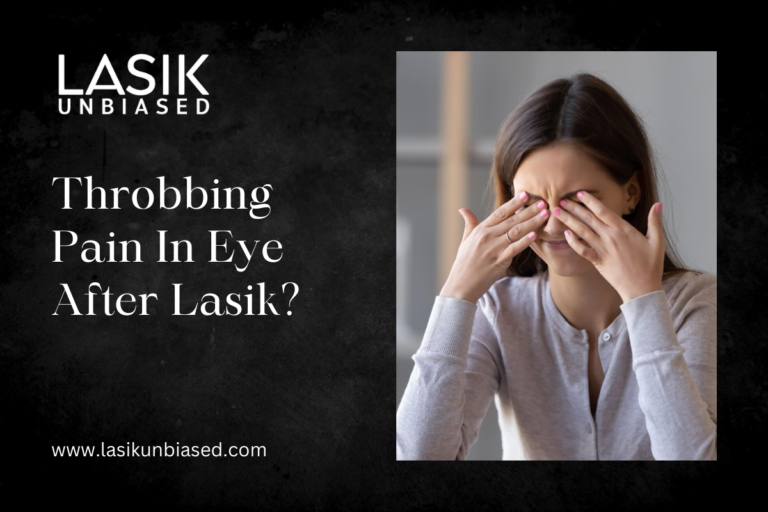LASIK surgery is widely regarded as a safe and effective procedure for correcting refractive vision issues. However, like any surgery, it has its share of potential side effects and complications.
One common concern some patients experience after undergoing LASIK surgery is throbbing pain in the eye. Although this type of discomfort is often temporary, it can be distressing and may cause concern. Understanding the causes of this pain, how to manage it, and when to seek medical advice can help ease anxiety and ensure a smoother recovery process.
What Causes Throbbing Pain After LASIK?
Throbbing pain following LASIK surgery is typically the result of several interconnected factors. Most of these causes are temporary, and the pain usually subsides as the eyes heal. However, in some cases, persistent or intense pain may indicate a more serious issue that requires medical attention.
One of the primary causes of throbbing pain after LASIK is post-surgical irritation. During LASIK, the corneal flap is created and temporarily lifted to reshape the cornea, which can irritate the sensitive nerve endings in the eye. This irritation can lead to throbbing sensations, especially in the first few hours to days after the procedure. It is usual for these nerve endings to take some time to regenerate and adapt to the changes made during surgery.
Another common cause of throbbing pain is dry eye syndrome. LASIK surgery can temporarily disrupt the tear-producing glands and nerves in the cornea, leading to a reduced ability to produce moisture. Dryness can cause discomfort and manifest as a throbbing or aching sensation, particularly when blinking or looking at bright lights. Dry eye symptoms are common post-LASIK but usually resolve as the cornea heals.
Additionally, light sensitivity is a prevalent issue after LASIK. The surgery alters the cornea’s structure, making it more light-sensitive. As a result, even everyday light exposure can lead to pain, discomfort, and throbbing sensations in the eye. This sensitivity often improves as the eyes continue to heal and adjust.
In some cases, inflammation may also contribute to throbbing pain after LASIK. The healing process involves inflammation of the corneal tissue, which can lead to discomfort, including a pulsating or throbbing sensation. Although inflammation is a normal part of the recovery process, excessive inflammation can sometimes be a sign of complications, such as an infection or flap displacement.
How Long Does Throbbing Pain Last After LASIK?
For most patients, throbbing pain after LASIK is short-lived and typically subsides within the first few days or weeks following surgery. The pain intensity usually decreases progressively as the eyes heal and adjust to the changes made during the procedure. Initially, patients may experience discomfort or mild pain that comes and goes, but the throbbing sensation often lessens significantly by the end of the first week.
However, the duration and intensity of throbbing pain can vary depending on several factors, including the individual’s healing response, the severity of dryness or inflammation, and adherence to post-operative care instructions. Light sensitivity and occasional throbbing pain may persist for some patients for a few weeks, but these symptoms should improve over time.
If throbbing pain continues beyond a few weeks or becomes increasingly intense, it is essential to contact an ophthalmologist to rule out potential complications. Persistent or worsening pain may indicate infection, flap complications, or other serious issues requiring prompt medical attention.
How to Manage Throbbing Pain After LASIK
There are several ways to manage throbbing pain and ensure a smoother recovery after LASIK. Most strategies involve managing dry eye symptoms, reducing light sensitivity, and following proper post-operative care guidelines.
One of the most critical steps in managing pain after LASIK is lubricating eye drops. The surgeon typically prescribes these drops, which can help soothe dry eyes, reduce irritation, and alleviate discomfort caused by dryness. Following the prescribed schedule for eye drop use is essential to ensure that the eyes remain moisturized and comfortable during the healing process.
Patients may also benefit from wearing sunglasses to reduce light sensitivity, especially outdoors or in brightly lit environments. Sunglasses protect from UV light, which can exacerbate discomfort, and help to reduce glare, making the healing process more comfortable.
During recovery, patients should avoid rubbing their eyes or putting unnecessary pressure on them. Rubbing can disrupt the corneal flap or exacerbate irritation, leading to further pain or complications. It is essential to be gentle with the eyes during the initial healing phase to avoid causing additional damage.
Taking breaks from screen time can also help minimize strain on the eyes, especially for those who spend long hours in front of computers, smartphones, or other digital devices. The 20-20-20 rule—looking away from the screen every 20 minutes and focusing on something 20 feet away for at least 20 seconds—can help reduce eye strain and alleviate throbbing pain.
Pain relievers such as ibuprofen or acetaminophen may also be recommended to manage mild discomfort. However, following the surgeon’s guidance regarding over-the-counter medications is essential, as some medicines may interfere with the healing process or cause side effects.
For patients with severe light sensitivity or dry eye symptoms, prescription eye drops like cyclosporine or corticosteroids may be prescribed to reduce inflammation and improve tear production. These drops can help manage symptoms of dryness and sensitivity, allowing for a more comfortable recovery.
When to Seek Medical Attention
While mild throbbing pain is expected during the recovery period after LASIK, there are certain situations when medical attention is necessary. If the pain becomes severe or persistent or worsens over time, it may be a sign of a complication. Patients should seek immediate medical care if they experience:
- Intense pain that does not improve with prescribed treatments
- Redness or swelling around the eyes or eyelids
- Blurry vision or fluctuating vision
- Discharge or pus from the eye
- Halos or starbursts around lights, which could signal flap complications
These symptoms could indicate an infection, corneal flap displacement, or other serious issues that require prompt medical attention.
By following post-operative care instructions, using prescribed lubricating drops, and managing light sensitivity and dryness, most patients can alleviate the throbbing sensation and recover comfortably. However, if the pain persists or worsens, it is crucial to consult an ophthalmologist to rule out complications and ensure proper healing. With the right care and attention, most individuals experience a smooth recovery and enjoy the long-term benefits of improved vision after LASIK.


